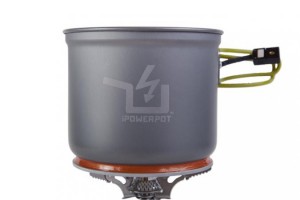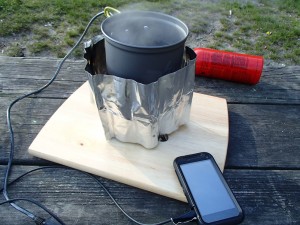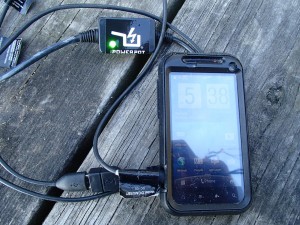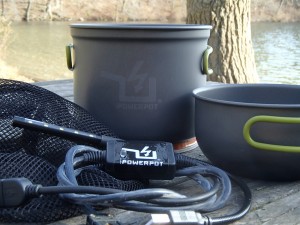Overview:
“The PowerPot is a lightweight thermoelectric generator that converts heat into DC electrical power. Simply add water to the pot and place it on a heat source appropriate for boiling water. The PowerPot will immediately start powering up your mobile electronics.” – Power Practical
The Deets:
Packed Size: 4.5”x5.5” or 4.5”x8” (with lid)
Weight: 12.1oz or 18.2oz (with lid and cord)
Capacity: 1.4L
USB Power Output: 5W @ 5V continuous (once water is boiling).
Charging Time: Depends on specific electronic device.
Compatible Devices: “Any small electronic USB-powered device”
MSRP: $149.00 (Click here to purchase your very own PowerPot!)
The Review:
The PowerPot V by Power Practical offers an exciting new spin on the concept of portable power. This pot is unlike any pot that you have ever seen before; it’s really a thermoelectric generator disguised as a regular old backpacking pot! Simply boil water in the PowerPot and it will convert heat into electricity to charge your small electronics including cell phones, GPS, iPods, and battery packs via a standard (5V) USB port! The incredible PowerPot V kit comes with a 5V USB regulator with 3ft-long , flame-resistant charging cable, lid-bowl combination, LED light-strip, and stuff sack. Of course you’ll have to bring along the USB charging cables specific to your small electronics. This compact pot-set is well-suited for use in the backcountry and can easily substitute for a standard pot set and portable charging unit in your kayak camping kit!
We had the chance to put the PowerPot through the paces on a windy day down by the pond and our first impressions were very good! The Power Pot was set-up per the instructions (half-filled with water) and heated with an MSR Simmerlite white-gas stove. The green light on the 5V USB regulator turned on almost instantaneously signaling that the power pot was ready to charge. The water boiled in about 7 minutes and it took about 20minutes to re-charge my smart phone (HTC Incredible 2) by 25%. The PowerPot continued to charge for about 1 minute after the stove was turned off before the regulator cut out. Nothing to it!
We were very impressed with the electricity-generating capabilities of the PowerPot; this little pot packs a whole lot of power! For example, the Biolite Camp Stove, a similar thermo-electric portable power product, is only able to output approximately 2W of power continuously to a 5V-USB port. The PowerPot is able to output 5W continuously once the water in the pot in boiling. This is great for at least two reasons. First, the power output of the PowerPot is much more stable due to the fact that the pot is utilizing a stable heat source (boiling water is always at 100C). Second, more power translates to shorter charge times! Power Practical claims that the PowerPot is compatible with all standard 5V-USB-powered devices. It certainly had no issue charging my smart phone (HTC Incredible 2), iPod nano, or rechargeable battery pack (Goal Zero Guide 10Plus) but we’re not willing to comment on universal compatibility given the wide-spread compatibility issues that similar power-generating devices have experienced.
The PowerPot is still a nice piece of gear even when you take the generator out of the equation. When you compare the PowerPot to other pots of its size (such as the MSR 1.3L Quick Solo Pot) you will find that it doesn’t weigh all that much more (~10oz including lid and power cord). This additional weight makes up for itself when you consider that you’ll no longer need to tote along a solar panel or back-up batteries. It’s a bit on the expensive side both as a pot (about 3x more expensive as the Quick Solo) and as a power generator (about 20% more expensive than the CampStove). However, you do experience some savings when you consider that your pot and generator are one in the same!
We found that setting up the PowerPot was quick and easy and appreciated how the integrated handles guide the power cable away from the heat. At one point during our testing we noticed that the cable had come in contact with the windshield for our stove. The shield was too hot to touch with our bare hands but the cable survived the experience without a scratch! We’re hesitant to comment on the long-tern durability of the PowerPot until we’ve used it for a while. We’re also interested in testing it out with other heat sources including canister stoves and wood-coal fires in the future to see how it does.
The PowerPot is designed for multi-tasking, i.e. boiling water for cooking while charging your small electronics. However, its design dictates a few important implications that should be considered. For one, the Power Pot must be filled at least half-way with water in order for the generator to function and to protect it from damage. This is perfect if you’re interested in boiling water to rehydrate foods, cook pasta or rice, or grab a hot cocoa (which accounts for 95% of the “cooking” that the average backpacker does). Any other cooking (without boiling water) will require that you bring along a standard pot in order to prevent damaging your PowerPot.
Also, our testing showed that it took about 20minutes (a reasonable amount of time to cook a meal) to charge my smart phone by 25%. This was roughly 30% faster than the time it took the Biolite CampStove to provide the same charge. However, to fully charge a device you’ll have to run the power pot well-beyond the “cooking stage.” This may require more fuel for your stove than you would typically carry if you were just cooking with it.
Finally, the PowerPot will continue to charge your device even after the heat source is removed. We experienced a short period of this (~1minute) during our testing but came to appreciate that this phenomenon is highly condition dependent and should not be relied upon especially when it’s cold and windy outside. This makes a lot of sense when you consider how the PowerPot works. Once the temperature differential between the generator plate and the water decreases the electricity production will decrease until the regulator kicks out.
All-in-all, the Power Practical PowerPot V is yet another innovative solution to our portable power needs and is something that kayak campers should be excited about. This little pot creates an impressive amount of power that will charge your cell phones, VHF radios, and other small electronics while you cook. It matches up well against other pots of its size in terms of both weight and function. In our opinion, the PowerPot V will be a bit hit amongst tech-savvy outdoor enthusiasts and kayak campers who now have an excellent alternative to allow them to eliminate both a standard pot set and small (typically under-powered) solar charger from their kit!
-Kayak Dave
Pros: Powerful and stable electric generator provides continuous 5W to USB port when water is boiling. Quick and easy set-up. Nice size and weight.
Cons: Requires that pot be at least half-filled with water during use (limits cooking options). Relatively expensive.
Test conditions: Windy. Temps in the low 50s. Heated with MSR Simmerlite white-gas stove.
Kayak Dave Rating:








2 Responses to Power Practical PowerPot V Review